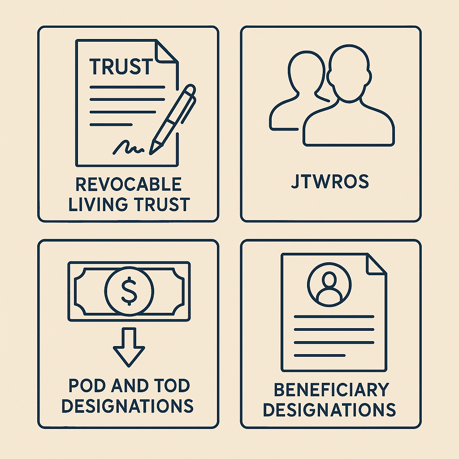Practical Ways to Avoid Probate: Pros, Cons, and Considerations
Probate can be a costly and time-consuming process. It’s also public, meaning anyone can see the details of your estate, your assets, and your beneficiaries. For families looking to preserve privacy, save money, and pass wealth efficiently, avoiding probate is a key part of estate planning. Here are the most common ways to do just that and what you need to consider before choosing a method.
Jared Mietzner, CFP®
5/20/20253 min read


1. Revocable Living Trust
What It Is:
A trust is a legal entity that holds title to your assets. You (the grantor) transfer ownership of your assets into the trust during your lifetime, maintain control as trustee, and name successor trustees and beneficiaries. At your death, assets in the trust pass directly to the named beneficiaries, no probate required.
Pros:
Avoids probate entirely for assets titled in the trust.
Maintains privacy — unlike a will, a trust is not part of the public record.
Continuity of management in case of incapacity.
Easier for out-of-state or multi-state property situations.
Cons:
Costs more upfront to set up compared to a will.
Requires ongoing maintenance — you must ensure assets are actually retitled into the trust.
If your state has inheritance or estate taxes, the trust might still need to report the corpus to the state, which could compromise privacy depending on local regulations.
Important Note:
The trust only avoids probate if funded properly. Bank accounts, real estate, investments must be retitled into the name of the trust. A trust sitting empty does nothing.
2. Joint Tenancy with Right of Survivorship (JTWROS)
What It Is:
Joint ownership of property where, upon the death of one owner, the surviving owner automatically inherits the deceased’s share. It’s a statutory probate avoidance mechanism.
Best Used When:
There’s a close relationship but no marital tie; think siblings, parent and adult child, or long-term partners.
Pros:
Simple and automatic transfer at death.
No court involvement or legal filings.
Immediate access to funds or property.
Cons:
Stepped-up basis is halved — meaning only the deceased's portion of the asset gets a step-up in basis for tax purposes. This can be a capital gains trap for the survivor if the asset is later sold.
Loss of control — both parties have equal rights. One owner can withdraw funds or sell the asset without the other's consent (in some cases).
Not ideal for complex estates or large assets with appreciation.
Example:
Say two siblings own a home in JTWROS. One dies. The survivor now owns the home fully but only receives a step-up in basis on 50% of the value. If the property has appreciated substantially, the survivor could face significant capital gains tax on their half when selling.
3. Payable-on-Death (POD) and Transfer-on-Death (TOD) Designations
What They Are:
You can name beneficiaries directly on bank accounts (POD) or brokerage accounts and, in some states, real estate (TOD). At your death, the asset transfers to the named beneficiary without probate.
Pros:
Quick and straightforward.
No court process — just provide a death certificate.
Can be used for liquid assets, ideal for immediate needs.
Cons:
No contingencies — if your beneficiary dies before you and you don’t update the form, the asset may still pass through probate.
Over-simplifies complex estates — not suitable for blended families, minors, or special needs beneficiaries without additional planning.
4. Beneficiary Designations (Retirement Accounts, Life Insurance)
What They Are:
These accounts typically let you name a primary and contingent beneficiary. Assets transfer directly upon death without probate.
Pros:
Fastest and easiest probate avoidance method.
Common with IRAs, 401(k)s, and life insurance.
Cons:
Still subject to income tax if not a Roth.
Mistakes are common — outdated beneficiaries, forgetting to name contingents, or naming minor children can cause complications.
Final Thoughts: Which Method is Best?
The answer depends on your goals:
Privacy and control? A revocable trust might be best.
Simplicity and small estate? Beneficiary designations and POD/TOD forms work well.
Own property jointly but not married? Be cautious. JTWROS may avoid probate but comes at a tax cost.
Most effective estate plans use a combination of these tools, not just one. But remember: avoiding probate shouldn’t come at the cost of increased taxes, family disputes, or poor asset management.
Your financial advisor should work with your qualified estate planner to design a strategy that fits your unique situation. What works for your neighbor may not be the right fit for you.
The information provided herein is intended solely for general informational purposes and should not be interpreted as personalized investment advice or an individualized recommendation. Investment strategies discussed may not be appropriate for every investor. Each individual should carefully evaluate any strategy in light of their unique financial situation before making investment decisions.
All opinions expressed are subject to change without notice in reaction to shifting market conditions. While data presented may come from third-party sources believed to be reliable, Mietzner Wealth Management cannot guarantee its accuracy, completeness, or reliability.
Any examples provided are purely illustrative and do not represent expected outcomes or guaranteed results.
This content is general in nature and is not intended to provide specific legal, tax, or investment advice. Tax regulations may change, potentially with retroactive effect. For advice tailored to your individual circumstances, consult with qualified professionals such as a CPA, financial planner, or investment advisor before acting on any of the information provided.
Please consult your tax advisor to determine what investment strategies are best for you based on your personal tax situation.
All investments involve risk, including the potential loss of principal.
Get in touch
Address
800 W El Camino Real, Ste 180
Mountain View, CA 94040
Contacts
408-786-5566
contact@mietznerwm.com
© 2025. All rights reserved.
Investment Advisory Services offered through Mietzner Wealth Management, LLC, a California Registered Investment Advisor.
